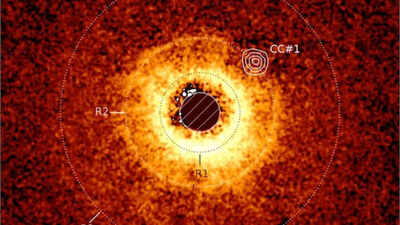The James Webb Space Telescope (JWST) has achieved a milestone by directly imaging its first new planet, TWA 7b. This discovery marks a significant advancement in the study of exoplanets.

TWA 7b is a low-mass planet, orbiting a young star approximately 111 light-years away. What sets this discovery apart is that TWA 7b is the least massive planet ever directly imaged outside our solar system. With a mass only 0.3 times that of Jupiter, or roughly 100 times the mass of Earth, it is significantly lighter than any other exoplanet previously captured in direct images.
The exoplanet orbits CE Antliae (TWA 7), a young, low-mass star located in the constellation Antlia. This star belongs to the TW Hydrae Association, a group of stars recognized for their youth. CE Antliae, estimated to be just 6.4 million years old, is a cosmic infant compared to our Sun, which is 4.6 billion years old. The star's youth and its nearly pole-on orientation relative to Earth made it an ideal target for JWST imaging.
The discovery of TWA 7b hinged on infrared imaging. Young, low-mass planets emit thermal radiation in the infrared spectrum, making JWST's capabilities perfectly suited for this task. The telescope's Mid-Infrared Instrument (MIRI), equipped with a coronagraph, was instrumental in the find.
A coronagraph blocks the overwhelming light of a star, enabling the detection of faint nearby objects like exoplanets. By using high-contrast imaging techniques, the JWST team identified a faint infrared source embedded within the debris disc surrounding TWA 7.
This source was found within a gap between rings of dust, an area predicted to be carved out by a planet's gravitational influence. Simulations confirmed that a planet with the mass of Saturn in that precise location could explain the observed structure.
The disc surrounding TWA 7 features three distinct rings separated by gaps. One of these gaps contains a narrow ring flanked by two dust-free regions, a pattern often associated with the gravitational effects of an orbiting planet. The infrared glow detected by JWST corresponds exactly to this ring gap. The planet's brightness, temperature (around 320 Kelvin or 47°C), and orbital distance (approximately 50 astronomical units from the star) all align with the predictions for a planet in this region.
The discovery of TWA 7b is significant for several reasons:
Astronomers believe that the structures observed in debris discs around young stars serve as blueprints for planetary formation. These rings and gaps represent regions where material is either accumulating to form planets or being cleared out by their gravitational pull. TWA 7b may be the first direct evidence of this process in action.
Researchers used advanced image subtraction methods to detect TWA 7b. By removing residual starlight, they were able to distinguish the planet from other celestial objects. This discovery highlights how new observing methods and instruments on JWST, such as the coronagraph and MIRI, are expanding our ability to discover previously inaccessible exoplanets. JWST's mid-infrared sensitivity now enables the detection of planets as massive and cold as Saturn, representing a significant improvement in direct imaging capabilities.
JWST's ability to suppress starlight and detect the faint heat signatures of small, cold planets is opening new avenues in exoplanet discovery. Astronomers are optimistic that even lighter planets, possibly Neptune-mass or even super-Earths, may soon be within reach.
Future observations will aim to:
Newer articles
Older articles
 Gavaskar Calls for Kuldeep Yadav's Inclusion in Second Test; Questions Bumrah's Fitness After Leeds Loss
Gavaskar Calls for Kuldeep Yadav's Inclusion in Second Test; Questions Bumrah's Fitness After Leeds Loss
 India's Harshit Rana Released from Test Squad Ahead of Second England Clash
India's Harshit Rana Released from Test Squad Ahead of Second England Clash
 Saucecode:
Nitish Rana Eyes Delhi Return After Disappointing Uttar Pradesh Spell
Saucecode:
Nitish Rana Eyes Delhi Return After Disappointing Uttar Pradesh Spell
 ICC Test Rankings: Pant Climbs to Career-Best, Bumrah Holds Top Spot as Root Reigns Supreme
ICC Test Rankings: Pant Climbs to Career-Best, Bumrah Holds Top Spot as Root Reigns Supreme
 India's Fielding Woes Blasted by Ex-Selector After Test Defeat Against England; Calls for Patience Amid Transition
India's Fielding Woes Blasted by Ex-Selector After Test Defeat Against England; Calls for Patience Amid Transition
 Elon Musk’s AI company will make Grok chatbot more accessible, here’s how
Elon Musk’s AI company will make Grok chatbot more accessible, here’s how
 India's Batting Collapses Trigger Debate: Gambhir Defends Lower Order, Cites Missed Catches, Workload Management as Factors in Test Loss
India's Batting Collapses Trigger Debate: Gambhir Defends Lower Order, Cites Missed Catches, Workload Management as Factors in Test Loss
 Bumrah's Birmingham Nets Spell: Accuracy, Angles, and Ambiguity Surround India Spearhead
Bumrah's Birmingham Nets Spell: Accuracy, Angles, and Ambiguity Surround India Spearhead
 IRCTC's AskDisha 2.0: AI Chatbot Streamlines Train Ticket Booking, Refunds, and Information Access
IRCTC's AskDisha 2.0: AI Chatbot Streamlines Train Ticket Booking, Refunds, and Information Access
 Wimbledon 2025: Alcaraz, Sabalenka, Fritz, and Anisimova Advance to Thrilling Semi-Final Showdowns
Wimbledon 2025: Alcaraz, Sabalenka, Fritz, and Anisimova Advance to Thrilling Semi-Final Showdowns